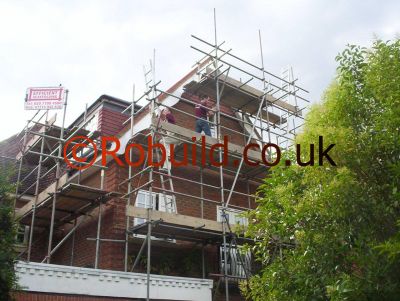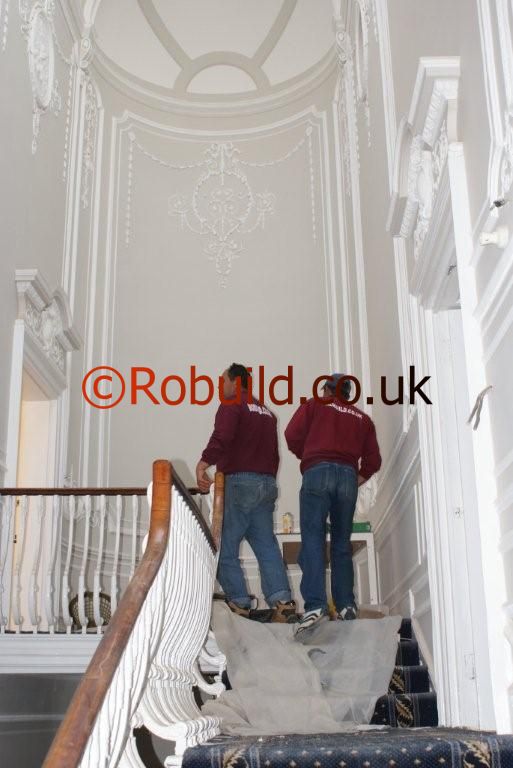Preparing the outside of your house before painting it is a job that has to be done. If you provide a sound surface the paint will last much longer.
If your house is in good order and has been decorated regularly, then the paintwork may need no more than a quick wash down and a light sanding before it’s ready for repainting. But if your house is in a rather worse state than this, take some time now to make a really good job of the preparation and you’ll have a much easier time in the future. The preparation may seem rather time consuming, but don’t be tempted to miss out any of the steps.
Properly applied, paint will protect your house for several years, but it won’t stick to an unsound surface. The most convenient order of working is to start at the top of the house and work down, and to do all the preparation before you start to paint so that dust and grit won’t fall on wet paint. When working at a height, make sure the ladder or platform is firm and secure.
Gutters and downpipes
Gutters manage to trap a surprising quantity of dirt and old leaves, so clear this out first. It’s a good idea to check that the gutter is at a regular slope towards the nearest downpipe. You can easily check this by pouring a bucket of water into one end and seeing if it all drains away. If puddles form, you’ll need to unscrew some of the gutter brackets and adjust the level of the gutter until the water flows away freely. Check all the joints for leaks and if you do find any, seal them with a mastic compound applied with a gun. Plastic gutters need little maintenance, and they don’t need painting. But if you want to change their colour, simply clean them thoroughly and wipe them over with a rag dipped in white spirit or turps to remove any grease spots before starting to paint. There’s no need for a primer or undercoat, but the painters & decorators may need two top coats for even coverge. Metal gutters and pipes need more attention as all rust has to be removed. Scrape off flaking paint first, then use a wire brush and emery paper to remove the rust. A wire brush attachment on an electric drill would make the cleaning easier (but wear a mask and goggles while using one). You can buy an anti-rust chemical from paint shops which is useful for badly rusted metalwork. It works by turning iron oxide (rust) into phosphate of iron which is inert and can be painted over. In any case, prime all bare metal immediately with either a red lead primer or a zinc chromate metal primer. Metal primers contain a rust-inhibitor which protects the metal against further corrosion, so don’t miss them out. If the gutters and pipes are in good condition with no sign of rust, simply wash them down and sand the surface lightly to key it ready for repainting.

Fascias and barge boards
Fascias and barge boards run along the top of a wall just below the roof. Fascias support the guttering below pitched roofs and edge flat ones, while barge boards are fitted beneath the roof tiles on gable ends. Because they are so high up, don’t worry too much about their appearance; the main consideration is protection as they are in such an exposed position. Clean out well behind the gutters as damp leaves or even bird’s nests can be lodged there. Then, using a wide scraper, remove all loose flaking paint, sand down the whole board surface and prime the bare patches. Fill holes and cracks with an exterior-grade filler or waterproof stopping and smooth it level while still damp using a filler knife. You can prime the filler when it’s dry.
Walls
The main surface materials and finishes used on the outside of your house are brick, stone, wood and render. Walls of brick and stone, especially when weathered, have a beauty all of their own and don’t really need painting. But the surface can become cracked and dirty and a coat of paint will cover up repairs that don’t match the original surface, and protect the wall from further damage. Examine the pointing and, if it has deteriorated, rake out the damaged parts and re-point with fresh mortar.
Use a mixture of about 1 part cement to 4 parts of fine sand, or buy a bag of readymixed mortar. Use a small trowel and try to match the original pointing in the surrounding brickwork. Don’t worry about hairline cracks as these will easily be covered by the paint. The white crystalline deposit which sometimes appears on brickwork is known as efflorescence. It is caused by watersoluble salts in the brick being brought to the surface, and should be brushed off with a dry brush. Don’t try to wash it off as this will only make it worse. The main types of render are plain, roughcast and pebbledash. Plain render can be applied to give a smooth finish or a textured Tyrolean’ finish, for example. Roughcast consists of pebbles mixed with mortar before application, and with pebbledash the pebbles are thrown on while the mortar is still wet.
Pebbledash deteriorates more quickly than the other types of render as, over the years, differences in rates of expansion between each pebble and the surrounding mortar may result in small surface cracks causing the pebbles to become loose and fall out. Paint will bind in the pebbles and protect small cracks.
When repairing any of these surfaces, try and achieve the same finish as the original, or as near as you can, so that when it’s repainted the repair won’t be too noticeable. Stop up cracks with mortar, using a mix of 1 part cement to 5 parts sand. Chip away very wide cracks until you reach a firm edge, then undercut this to provide a good key for the new mortar. Dampen the surface, then stop up with a trowel. Use a float if the surface is plain, or texture the surface to match the surrounding area. Where the rendering is pebbledash, throw on pebbles with a small trowel while the mortar is still wet, then press them into the mortar lightly with a flat piece of wood.
Mould and stains
If there’s any sign of mould or algae on the wall, treat this next. Mix up a solution of 1 part household bleach to 4 parts water and paint this on the affected area. Be generous with the solution and cover the area well. Leave 2 The paint must first be stripped off to expose the knot. Use any method of stripping, and scrape the paint off with a shavehook or scraper. growth, then wash off thoroughly and brush down with a stiff brush. Rusty gutters, pipes and metal fittings can all cause stains if rusty water drips down the wall. So cure any leaks first and clean and prime all metal to ensure there’s no trace of rust. Mould and algae thrive on damp walls; even if you can’t actually see any growth on a damp patch, there may be some spores lurking there, so you should make absolutely sure that you sterilise all stains with the bleach solution just to make sure.
Dusty or chalky walls
All walls, whether dusty or not, should be brushed down thoroughly to remove any loose material. But if, after brushing, the wall is still dusty or chalky, if a cement-based paint was used previously to decorate it, or if the wall is porous, you’ll have to brush on a stabilising solution. This will bind together loose particles to allow the paint to stick, and from being sucked in too much.
The stabiliser also helps to waterproof the wall and you can paint it on as an extra iayer of protection whether it’s really necessary or not. Most stabilisers are colourless, but offwhite stabiliser/primers are available and this would be a good choice if you were planning to paint your house in a light colour, as it could save one coat of the finishing colour.
These off-white stabilisers, however, are not recommended for use on surfaces painted with a cement-based paint. Stabilisers must be painted on a dry wall and should be left to dry for 24 hours before painting on the top coat. Don’t paint if ram is expected. Clean your brush in white spirit or turps as soon as you stop work. Timber cladding If the cladding or weatherboarding is bare and you want to leave the natural wood surface showing, it should be treated with a water-repellent wood preservative to give protection against damp penetration and decay. The preservative is available clear or pigmented with various colours. If the wood has been varnished, scrape off the old varnish and sand down well, following the grain of the wood.
Fill cracks and holes with plastic wood or a tinted stopper to match the colour of the wood. If you wish to paint the surface you’ll have to wait a year or so for the water-repellent agents in the preservative to disperse before priming with an aluminium wood primer.
Woodwork
If the paintwork on the windows is in good condition all you need do is give them a wash and a light sanding. If the paint is cracked and flaking, a little more preparation is needed. To check if the paint surface needs stripping, lay on a piece of sticky tape and see if it lifts off any paint. Occasional chipped or blistered portions can be scraped off and cut back to a firm edge.
As long as the edge is feathered smooth with glasspaper, it shouldn’t show too much. If previous coatings are too thick for this treatment, build up the surface with outdoor grade hard stopping until it is just proud of the surrounding paint, then sand level when it’s dry. Don’t allow the stopping to extend too far over the edge of the damage or it’ll be difficult to sand it smooth.
There comes a time, however, when the condition of the old coating has become so bad that complete stripping is advisable.

A blow-torch or an electric hot air stripper are the quickest tools to use. Start at the bottom softening the paint, and follow up immediately with a scraper. Hold the scraper at an angle so the hot paint doesn’t fall on your hand, and don’t hold it above the flame or it may become too hot to hold. Try not to concentrate the flame too long on one
though this rarely matters on exterior woodwork which will be over-painted again. Always be extremely careful when using a blowtorch, and keep a bucket of water or sand nearby in case something does catch fire. A chemical paint stripper is the best method to use near glass in case the glass cracks under the heat of a blow-torch.




